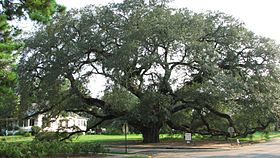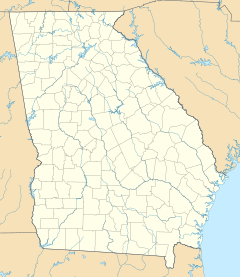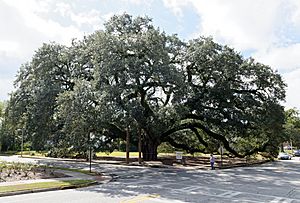The Big Oak facts for kids
Quick facts for kids The Big Oak |
|
|---|---|

The Big Oak, located in Thomasville, Georgia is a live oak dating back to about 1680, and is one of the largest of its kind east of the Mississippi River.
|
|
| Species | Southern live oak (Quercus virginiana) |
| Coordinates | 30°50′28″N 83°58′54″W / 30.841114°N 83.981721°W |
The Big Oak is a giant live oak tree found in Thomasville, Georgia, in the United States. It stands proudly at the corner of Crawford Street and Monroe Street. This amazing tree is one of many historic landmarks in Thomasville.
The Big Oak was one of the first trees to be officially listed by the Live Oak Society. P.C. Andrews registered it in 1936, making it the 49th live oak on their list. Back then, the tree's trunk measured about 21 feet 6 inches around!
Contents
What is a Live Oak Tree?
Quercus virginiana is a type of oak tree. You can find these trees growing from Texas all the way to Florida and up to Virginia. People often call them live oaks, southern live oaks, or Texas live oaks.
The size of these trees can change depending on how close they are to the coast. Bigger live oaks usually grow further inland. Trees closer to the ocean tend to be a bit smaller.
Live Oak Flowers and Growth
Quercus virginiana trees grow small flowers in the spring. The wind helps to pollinate these flowers. Live oaks are known for growing very quickly when they are young. However, as they get older, their growth rate slows down.
The Big Oak's Long History
The Big Oak tree is super old! It started growing around the year 1680. This makes it one of the oldest live oaks in the entire country. Many groups, like the International Society for Agriculture in 1987, have recognized the tree for its incredibly long lifespan.
This tree has managed to survive for centuries, even as towns grew around it. It is still a very important landmark in Thomasville today.
The Chastain Family and the Park
The land where the Big Oak stands used to belong to Mr. and Mrs. John Albert Chastain. The Chastain family owned this property from 1906 until the mid-1960s. They raised their family in a home right under this huge live oak for almost 60 years. Mr. Chastain's mother even remembered a time when the Big Oak was in a pond, not just a dry lot!
In 1966, Mrs. Elisabeth Ireland Poe and the city of Thomasville bought the property. They turned it into a public park for everyone to enjoy. Mrs. Poe was well-known in Thomasville for owning Pebble Hill Plantation. She loved preserving the history of Thomasville, which is why she helped buy the tree's land.
A Special Gazebo and Wall
Also in 1966, Mrs. Otto Carter of Meigs, Georgia donated a historic Victorian-style gazebo. This type of gazebo is quite rare today. The gazebo was fixed up and is still a main feature of the park.
In 1969, the Thomasville Garden Club helped make the park even more beautiful. They used a special fund to build a brick wall with a lattice design on two sides of the property. People in the community call this wall "The Living Wall." The park where the Big Oak stands was officially dedicated to Mrs. Elisabeth Ireland Poe on February 7, 1982.
A Presidential Visit
The Big Oak even had a famous visitor in 1958! Dwight D. Eisenhower, who was the President of the United States, stopped by. He was on a hunting trip in Thomasville. On his way to the airport, President Eisenhower asked his driver to stop so he could take a photo of the tree. He got out of his vehicle, stood on a nearby porch, took his picture, and then got back in his car.
Clearing Up Misunderstandings
Some people have mistakenly thought the Big Oak was used for sad events in Thomasville's history. However, Jack Hadley, who is the Curator of Thomasville’s Black History Museum, says there is no proof of this. In 2017, he wrote in a local newspaper that in his 80+ years of living in and researching Thomasville, he had "never seen any proof, documentation and no one has provided me any documentation about the Big Oak Tree in downtown as a lynching tree."
Keeping the Big Oak Safe
Many things have been done to protect this amazing tree in Thomasville. These efforts include adding support cables to its branches. There's also an underground watering system and an above-ground sprinkler system. Plus, a special "on call" tree surgeon is ready to help if needed. The support cables are woven around the tree to make its large limbs stronger. Some of these limbs are just a few feet above the ground!
Accidents and Repairs
Even with all the care, accidents have happened. In June 1973, a truck hit the tree. The damage was small, but the driver was charged by police for not staying on the city truck route. In 1975, two more incidents damaged the Big Oak. Large trucks driving through the area without enough room hit two limbs. The Davey Tree Company worked for days to protect the tree and do regular check-ups on its branches.
In 1978, a 14-foot broken limb was carefully removed from the tree. This was done to stop further damage. Waymon Dekle, who was the superintendent of parks and cemeteries, explained, "When we find a diseased or damaged part it should be cut off or we could run the risk of losing the entire tree."
The Big Oak has continued to grow bigger over the past century. It will keep growing if people take steps to keep it safe. When the Big Oak was registered in 1936, it was 49 feet 9 inches tall. Its trunk was 21 feet 6.5 inches around, and its branches spread 146 feet 8 inches wide. Almost 40 years later, the tree had grown a lot! It was 68 feet tall, 22 feet around, and its branches spread 155 feet. This showed the Oak was doing very well in Thomasville.
The Big Oak Today
People still work hard today to protect this historic tree from damage. However, some damage still occurs. On November 30, 2005, a truck driver named James Hayden hit two of the tree's large limbs, pulling them from the tree. The Thomasville Police Department charged the driver for "Disobeying a traffic control device."
The Big Oak is a very popular spot for weddings and other get-togethers. In 1985 alone, 23 weddings happened under the tree! Many parties for different community events are held in the gazebo. People also have Easter sunrise services, picnics, and school field trips there. The Big Oak is one of Thomasville's many fun places for tourists to visit.
The Baby Big Oak
In 2005, the Big Oak produced acorns for the first time in many years! That fall, Mrs. Carol Singletary, who is the granddaughter of John Albert Chastain, collected over 100 acorns. She took care of them as they started to grow. When they were big enough, she put them in pots and kept raising them until they became seedlings.
Mrs. Singletary gave some of these young trees to relatives who share her family's history with the property. Her sister, Rebecca Hasty Boswell, raised three of the seedlings. On Arbor Day in 2009, Mrs. Singletary gave one of these seedlings to Sue White of Pebble Hill Plantation. This new tree was planted at Pebble Hill Plantation and is now called "The Baby Big Oak."



